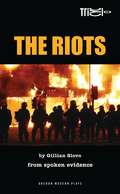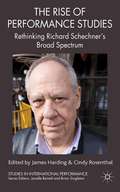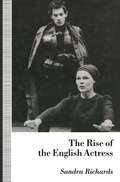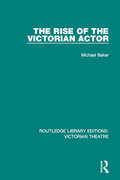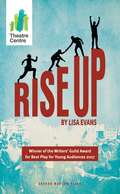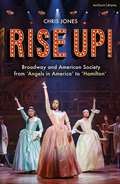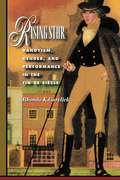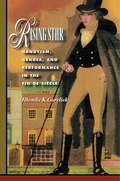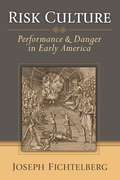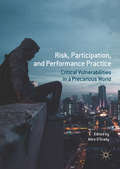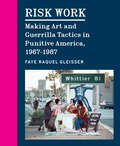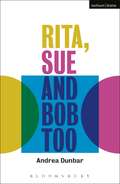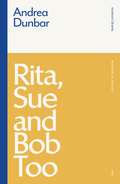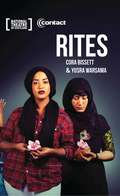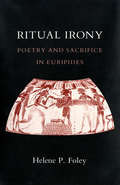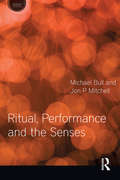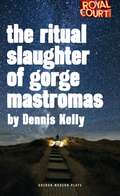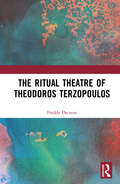- Table View
- List View
The Riots (Oberon Modern Plays)
by Gillian SlovoThe Government has so far refused a Public Inquiry into the riots that shook our cities in the Summer of 2011, so the Tricycle is mounting its own. This verbatim play builds a real-time picture of the riots as they unfolded. And then, from interviews with politicians, police, teachers, lawyers, community leaders, as well as victims and on-lookers, The Riots analyses what happened, why it happened, and what we should do towards making a better future for ourselves and our city. Astonishing stories and equally astonishing conclusions told by the many voices that have been stirred up by the riots.
The Rise of Performance Studies: Rethinking Richard Schechner's Broad Spectrum (Studies in International Performance)
by James M. Harding and Cindy RosenthalFew individuals have positioned their work more controversially or consequently than Richard Schechner within the pivotal debates that define Performance Studies. The Rise of Performance Studies is the first collection of essays to critically examine the profound contributions that Schechner has made to Performance Studies as a discipline.
Rise of the English Actress
by Sandra RichardsAn account of the English actress's view of her own rise up to social and professional prominence from 1600 to the present. Examining the actress's experience as distinct from the actor's, this book charts her influence on each age's views of women's nature and their role in society.
The Rise of the Victorian Actor (Routledge Library Editions: Victorian Theatre)
by Michael BakerOriginally published in 1978. Between 1830 and 1890 the English theatre became recognisably modern. Standards of acting and presentation improved immeasurably, new playwrights emerged, theatres became more comfortable and more intimate and playgoing became a national pastime with all classes. The actor’s status rose accordingly. In 1830 he had been little better than a social outcast; by 1880 he had become a member of a skilled, relatively well-paid and respected profession which was attracting new recruits in unprecedented numbers. This is a social history of Victorian actors which seeks to show how wider social attitudes and developments affected the changing status of acting as a profession. Thus the stage’s relationship with the professional world and the other arts is dealt with and is followed by an assessment of the moral and religious background which played so decisive a part in contemporary attitudes to actors. The position of actresses in particular is given special consideration. Many non-theatrical sources are used here and there is a survey of salaries and working conditions in the theatre to show how the rising social status of the actor was matched by changes in his theatrical standing. A novel area of study is covered in tracing the changing social composition of the acting profession over the period and in exploring the case-histories of three generations of performers.
The Rise of the Victorian Actor (Routledge Library Editions: Victorian Theatre)
by Michael BakerOriginally published in 1978. Between 1830 and 1890 the English theatre became recognisably modern. Standards of acting and presentation improved immeasurably, new playwrights emerged, theatres became more comfortable and more intimate and playgoing became a national pastime with all classes. The actor’s status rose accordingly. In 1830 he had been little better than a social outcast; by 1880 he had become a member of a skilled, relatively well-paid and respected profession which was attracting new recruits in unprecedented numbers. This is a social history of Victorian actors which seeks to show how wider social attitudes and developments affected the changing status of acting as a profession. Thus the stage’s relationship with the professional world and the other arts is dealt with and is followed by an assessment of the moral and religious background which played so decisive a part in contemporary attitudes to actors. The position of actresses in particular is given special consideration. Many non-theatrical sources are used here and there is a survey of salaries and working conditions in the theatre to show how the rising social status of the actor was matched by changes in his theatrical standing. A novel area of study is covered in tracing the changing social composition of the acting profession over the period and in exploring the case-histories of three generations of performers.
Rise Up (Oberon Modern Plays)
by Lisa EvansThe tide was turning – though local governments disagreed, it would soon be illegal to segregate black Americans from white Americans on public buses, in waiting rooms or in restaurants. And yet – in the early 1960s, many states across the south of America kept discriminating against African Americans… In modern day Britain, four performers tell the stories of the Freedom Riders – principled citizens riding buses across Alabama and Mississippi, drawing attention to this illegal discrimination and facing up to terrifying violence with peaceful resistance. The story of the Freedom Riders is one of ordinary people becoming a civil rights movement, taking on the establishment and changing the world. In a time of Michael Brown, Trayvon Martin and Mark Duggan, what does it mean for people to come together and rise up?
Rise Up!: Broadway and American Society from 'Angels in America’ to ‘Hamilton’
by Chris JonesPenned by one of America's best-known daily theatre critics and organized chronologically, this lively and readable book tells the story of Broadway's renaissance from the darkest days of the AIDS crisis, via the disaster that was Spiderman: Turn off the Dark through the unparalleled financial, artistic and political success of Lin-Manuel Miranda's Hamilton. It is the story of the embrace of risk and substance. In so doing, Chris Jones makes the point that the theatre thrived by finally figuring out how to embrace the bold statement and insert itself into the national conversation - only to find out in 2016 that a hefty sector of the American public had not been listening to what it had to say. Chris Jones was in the theatres when and where it mattered. He takes readers from the moment when Tony Kushner's angel crashed (quite literally) through the ceiling of prejudice and religious intolerance to the triumph of Hamilton, with the coda of the Broadway cast addressing a new Republican vice-president from the stage. That complex performance - at once indicative of the theatre's new clout and its inability to fully change American society for the better - is the final scene of the book.
Rise Up!: Broadway and American Society from 'Angels in America’ to ‘Hamilton’
by Chris JonesPenned by one of America's best-known daily theatre critics and organized chronologically, this lively and readable book tells the story of Broadway's renaissance from the darkest days of the AIDS crisis, via the disaster that was Spiderman: Turn off the Dark through the unparalleled financial, artistic and political success of Lin-Manuel Miranda's Hamilton. It is the story of the embrace of risk and substance. In so doing, Chris Jones makes the point that the theatre thrived by finally figuring out how to embrace the bold statement and insert itself into the national conversation - only to find out in 2016 that a hefty sector of the American public had not been listening to what it had to say. Chris Jones was in the theatres when and where it mattered. He takes readers from the moment when Tony Kushner's angel crashed (quite literally) through the ceiling of prejudice and religious intolerance to the triumph of Hamilton, with the coda of the Broadway cast addressing a new Republican vice-president from the stage. That complex performance - at once indicative of the theatre's new clout and its inability to fully change American society for the better - is the final scene of the book.
Rising Star: Dandyism, Gender, and Performance in the Fin de Siècle
by Rhonda K. GarelickCelebrity personalities, who reign over much of our cultural landscape, owe their fame not to specific deeds but to the ability to project a distinct personal image, to create an icon of the self. Rising Star is a fascinating look at the roots of this particular form of celebrity. Here Rhonda Garelick locates a prototype of the star personality in the dandies and aesthete literary figures of the nineteenth century, including Beau Brummell, Baudelaire, Mallarmé, and Oscar Wilde, and explores their peculiarly charged relationship with women and performance. When fin-de-siècle aesthetes turned their attention to the new, "feminized" spectacle of mass culture, Garelick argues, they found a disturbing female counterpart to their own highly staged personae. She examines the concept of the broadcasted self-image in literary works as well as in such unwritten cultural texts as the choreography and films of dancer Loie Fuller, the industrialized spectacles of European World Fairs, and the cultural performances taking place today in fields ranging from entertainment to the academy. Recent dandy-like figures such as the artist formerly known as Prince, Madonna, Jacques Derrida, and Jackie O. all share a legacy provided by the encounter between "high" and early mass culture. Garelick's analysis of this encounter covers a wide range of topics, from the gender complexity of the European male dandy and the mechanization of the female body to Orientalist performance, the origins of cinema, and the emergence of "crowd" theory and mass politics.
Rising Star: Dandyism, Gender, and Performance in the Fin de Siècle
by Rhonda K. GarelickCelebrity personalities, who reign over much of our cultural landscape, owe their fame not to specific deeds but to the ability to project a distinct personal image, to create an icon of the self. Rising Star is a fascinating look at the roots of this particular form of celebrity. Here Rhonda Garelick locates a prototype of the star personality in the dandies and aesthete literary figures of the nineteenth century, including Beau Brummell, Baudelaire, Mallarmé, and Oscar Wilde, and explores their peculiarly charged relationship with women and performance. When fin-de-siècle aesthetes turned their attention to the new, "feminized" spectacle of mass culture, Garelick argues, they found a disturbing female counterpart to their own highly staged personae. She examines the concept of the broadcasted self-image in literary works as well as in such unwritten cultural texts as the choreography and films of dancer Loie Fuller, the industrialized spectacles of European World Fairs, and the cultural performances taking place today in fields ranging from entertainment to the academy. Recent dandy-like figures such as the artist formerly known as Prince, Madonna, Jacques Derrida, and Jackie O. all share a legacy provided by the encounter between "high" and early mass culture. Garelick's analysis of this encounter covers a wide range of topics, from the gender complexity of the European male dandy and the mechanization of the female body to Orientalist performance, the origins of cinema, and the emergence of "crowd" theory and mass politics.
Risk Culture: Performance and Danger in Early America
by Joseph Fichtelberg"As a number of recent studies have shown, the north European commercial world made the precise calculation of risk a central concern of the intellectual project of exploration, trade, and colonization. The great merit of Fichtelberg's book is systematizing the imaged world of dangers, and charting the various kinds of ritual and discursive performances marshaled to deal with the pressure of the unspeakable in early America from the 17th into the early 19th century. The readings of texts are invariably careful, and the points made, persuasive." ---David Shields, University of South Carolina Risk Culture is the first scholarly book to explore how strategies of performance shaped American responses to modernity. By examining a variety of early American authors and cultural figures, from John Smith and the Salem witches to Phillis Wheatley, Susanna Rowson, and Aaron Burr, Joseph Fichtelberg shows how early Americans created and resisted a dangerously liberating new world. The texts surveyed confront change through a variety of performances designed both to imagine and deter menaces ranging from Smith's hostile Indians, to Wheatley's experience of slavery, to Rowson's fear of exposure in the public sphere. Fichtelberg combines a variety of scholarly approaches, including anthropology, history, cultural studies, and literary criticism, to offer a unique synthesis of literary close reading and sociological theory in the service of cultural analysis. Joseph Fichtelberg is Professor of English and Chair of the English Department at Hofstra University.
Risk, Participation, and Performance Practice: Critical Vulnerabilities in a Precarious World
by Alice O'GradyThis book explores a range of contemporary performance practices that engage spectators physically and emotionally through active engagement and critical involvement. It considers how risk has been re-configured, re-presented and re-packaged for new audiences with a thirst for performances that promote, encourage and embrace risky encounters in a variety of forms. The collection brings together established voices on performance and risk research and draws them into conversation with next generation academic-practitioners in a dynamic reappraisal of what it means to risk oneself through the act of making and participating in performance practice. It takes into account the work of other performance scholars for whom risk and precarity are central concerns, but seeks to move the debate forwards in response to a rapidly changing world where risk is higher on the political, economic and cultural agenda than ever before.
Risk, Participation, and Performance Practice: Critical Vulnerabilities in a Precarious World
by Alice O'GradyThis book explores a range of contemporary performance practices that engage spectators physically and emotionally through active engagement and critical involvement. It considers how risk has been re-configured, re-presented and re-packaged for new audiences with a thirst for performances that promote, encourage and embrace risky encounters in a variety of forms. The collection brings together established voices on performance and risk research and draws them into conversation with next generation academic-practitioners in a dynamic reappraisal of what it means to risk oneself through the act of making and participating in performance practice. It takes into account the work of other performance scholars for whom risk and precarity are central concerns, but seeks to move the debate forwards in response to a rapidly changing world where risk is higher on the political, economic and cultural agenda than ever before.
Risk Work: Making Art and Guerrilla Tactics in Punitive America, 1967–1987
by Faye Raquel GleisserHow artists in the US starting in the 1960s came to use guerrilla tactics in performance and conceptual art, maneuvering policing, racism, and surveillance. As US news covered anticolonialist resistance abroad and urban rebellions at home, and as politicians mobilized the perceived threat of “guerrilla warfare” to justify increased police presence nationwide, artists across the country began adopting guerrilla tactics in performance and conceptual art. Risk Work tells the story of how artists’ experimentation with physical and psychological interference from the late 1960s through the late 1980s reveals the complex and enduring relationship between contemporary art, state power, and policing. Focusing on instances of arrest or potential arrest in art by Chris Burden, Adrian Piper, Jean Toche, Tehching Hsieh, Pope.L, the Guerrilla Girls, Asco, and PESTS, Faye Raquel Gleisser analyzes the gendered, sexualized, and racial politics of risk-taking that are overlooked in prevailing, white-centered narratives of American art. Drawing on art history and sociology as well as performance, prison, and Black studies, Gleisser argues that artists’ anticipation of state-sanctioned violence invokes the concept of “punitive literacy,” a collectively formed understanding of how to protect oneself and others in a carceral society.
Risse als materielles Schauspiel: Performative Figuren in Szenarien von Kunst und Philosophie (Theater #150)
by Holger HartungRisse schlummern oft lange unbeachtet, bis sie plötzlich in das Feld unserer Aufmerksamkeit springen. Als materielles Schauspiel bilden sie nicht nur in Kunst und Philosophie ein neues Untersuchungsfeld, sondern auch in der Theaterwissenschaft. Der Band nimmt die Verwandlungen von Rissfiguren in Texten Martin Heideggers und Jacques Derridas als Ausgangspunkt und stellt diese in den Spiegel einer Kulturgeschichte vielfältiger Rissdarstellungen. Fünf künstlerische Arbeiten unterstreichen exemplarisch die tiefgehende Affinität von Rissfiguren und theatralen Szenarien und zeigen, wie sich diese durch Themen wie kollektive Traumata, Globalität, Migration bis hin zu Ökologie immer wieder aktualisiert.
Rita, Sue and Bob Too (Modern Plays)
by Andrea DunbarDo you think it would be better if you and me got ourselves steady boyfriends?Best friends Rita and Sue get a lift home from married Bob after babysitting his kids. When he takes the scenic route and offers them a bit of fun, the three start a fling each of them think they control.Andrea Dunbar's semi-autobiographical play, written for the Royal Court Theatre in 1982 when she was just 19, is a vivid portrait of girls caught between brutal childhood and an unpromising future, both hungry for adult adventure.Told with wicked humour, startling insight and a great ear for dialogue, this new edition of Rita Sue and Bob Too was published to coincide with director Max Stafford-Clark's major new production produced by Out of Joint, Bolton Octagon and the Royal Court Theatre.
Rita, Sue and Bob Too (Modern Plays)
by Andrea DunbarDo you think it would be better if you and me got ourselves steady boyfriends?Best friends Rita and Sue get a lift home from married Bob after babysitting his kids. When he takes the scenic route and offers them a bit of fun, the three start a fling each of them think they control.Andrea Dunbar's semi-autobiographical play, written for the Royal Court Theatre in 1982 when she was just 19, is a vivid portrait of girls caught between brutal childhood and an unpromising future, both hungry for adult adventure.Told with wicked humour, startling insight and a great ear for dialogue, this new edition of Rita Sue and Bob Too was published to coincide with director Max Stafford-Clark's major new production produced by Out of Joint, Bolton Octagon and the Royal Court Theatre.
Rita, Sue and Bob Too (Modern Classics)
by Andrea Dunbar“A bleak and brilliant testament to a life of fleeting pleasure and diminished expectations … a play of sharp observation, a document of its times.” The GuardianBest friends Rita and Sue get a lift home from married Bob after babysitting his kids. When he takes the scenic route and offers them a bit of fun, the three start a fling each of them think they control.Andrea Dunbar's semi-autobiographical play, written for the Royal Court Theatre in 1982 when she was just 19, is a vivid portrait of girls caught between brutal childhood and an unpromising future, both hungry for adult adventure.Told with wicked humour, startling insight and a great ear for dialogue, Rita Sue and Bob Too offers an unwavering portrait of a world of limitations and urban desolation.Published for the first time in Methuen Drama's Modern Classics series, featuring a new introduction by Katie Beswick.
Rita, Sue and Bob Too (Modern Classics)
by Andrea Dunbar“A bleak and brilliant testament to a life of fleeting pleasure and diminished expectations … a play of sharp observation, a document of its times.” The GuardianBest friends Rita and Sue get a lift home from married Bob after babysitting his kids. When he takes the scenic route and offers them a bit of fun, the three start a fling each of them think they control.Andrea Dunbar's semi-autobiographical play, written for the Royal Court Theatre in 1982 when she was just 19, is a vivid portrait of girls caught between brutal childhood and an unpromising future, both hungry for adult adventure.Told with wicked humour, startling insight and a great ear for dialogue, Rita Sue and Bob Too offers an unwavering portrait of a world of limitations and urban desolation.Published for the first time in Methuen Drama's Modern Classics series, featuring a new introduction by Katie Beswick.
Rites (Oberon Modern Plays)
by Cora Bissett Yusra WarsamaRites is a powerful and provocative production exploring the deep-rooted cultural practice of Female Genital Mutilation. This ritual of enforced cutting has been performed for centuries and millions of girls worldwide, often as young as five years old, are still subjected to it. The reasons are complicated and myriad. It depends who you are, and it depends what you’ve been taught. Some things are simple though: FGM is still happening across the world. FGM is happening in the UK, here and now.
Ritual Irony: Poetry and Sacrifice in Euripides
by Helene P. FoleyRitual Irony is a critical study of four problematic later plays of Euripides: the Iphigenia in Aulis, the Phoenissae, the Heracles, and the Bacchae.Examining Euripides' representation of sacrificial ritual against the background of late fifth-century Athens, Helene P. Foley shows that each of these plays confronts directly the difficulty of making an archaic poetic tradition relevant to a democratic society. She explores the important mediating role played by choral poetry and ritual in the plays, asserting that Euripides' sacrificial metaphors and ritual performances link an anachronistic mythic ideal with a world dominated by "chance" or an incomprehensible divinity.Foley utilizes the ideas and methodology of contemporary literary theory and symbolic anthropology, addressing issues central to the emerging dialogue between the two fields. Her conclusions have important implications for the study of Greek tragedy as a whole and for our understanding of Euripides' tragic irony, his conception of religion, and the role of his choral odes.Assuming no specialized knowledge, Ritual Irony is aimed at all readers of Euripidean tragedy. It will prove particularly valuable to students and scholars of classics, comparative literature, and symbolic anthropology.
Ritual, Performance and the Senses (Sensory Studies)
by Michael BullRitual has long been a central concept in anthropological theories of religious transmission. Ritual, Performance and the Senses offers a new understanding of how ritual enables religious representations – ideas, beliefs, values – to be shared among participants. Focusing on the body and the experiential nature of ritual, the book brings together insights from three distinct areas of study: cognitive/neuroanthropology, performance studies and the anthropology of the senses. Eight chapters by scholars from each of these sub-disciplines investigate different aspects of embodied religious practice, ranging from philosophical discussions of belief to explorations of the biological processes taking place in the brain itself. Case studies range from miracles and visionary activity in Catholic Malta to meditative practices in theatrical performance and include three pilgrimage sites: the Church of the Holy Sepulchre in Jerusalem, the festival of Ramlila in Ramnagar, India and the mountain shrine of the Lord of the Shiny Snow in Andean Peru.Understanding ritual allows us to understand processes at the very centre of human social life and humanity itself, making this an invaluable text for students and scholars in anthropology, cognitive science, performance studies and religious studies.
Ritual, Performance and the Senses (Sensory Studies)
by Michael Bull Jon P. MitchellRitual has long been a central concept in anthropological theories of religious transmission. Ritual, Performance and the Senses offers a new understanding of how ritual enables religious representations – ideas, beliefs, values – to be shared among participants. Focusing on the body and the experiential nature of ritual, the book brings together insights from three distinct areas of study: cognitive/neuroanthropology, performance studies and the anthropology of the senses. Eight chapters by scholars from each of these sub-disciplines investigate different aspects of embodied religious practice, ranging from philosophical discussions of belief to explorations of the biological processes taking place in the brain itself. Case studies range from miracles and visionary activity in Catholic Malta to meditative practices in theatrical performance and include three pilgrimage sites: the Church of the Holy Sepulchre in Jerusalem, the festival of Ramlila in Ramnagar, India and the mountain shrine of the Lord of the Shiny Snow in Andean Peru.Understanding ritual allows us to understand processes at the very centre of human social life and humanity itself, making this an invaluable text for students and scholars in anthropology, cognitive science, performance studies and religious studies.
The Ritual Slaughter of Gorge Mastromas (Oberon Modern Plays)
by Dennis KellyIf you could lie without flinching, corrupt without caring and succeed at all costs – how far could you go…how much could you make?From the early promise of the 70s through to unrelenting capitalism of the 80s and 90s, follow Gorge on the journey from innocence to savage greed and knotted honesty, as he invents three golden rule for success, whatever the cost.An electrifying dark tale.
The Ritual Theatre of Theodoros Terzopoulos
by Freddy DecreusThe Ritual Theatre of Theodoros Terzopoulos outlines the story of the Athenian-based Attis Theatre and the way its founder and director, Theodoros Terzopoulos, introduced bio-energetic presences of the body on the stage, in an attempt to redefine and reappraise what it means today not only to have a body, but to fully be a body. Terzopoulos created a very specific attitude towards life and death, and it is this broad perspective on energy and consciousness that makes his work so appealing both to a general public and to students of arts, theatre and drama. Freddy Decreus’ study charts the career of Greece’s most acclaimed theatre director and provides a spiritual and philosophic answer in times where former Western meta-narratives have failed.
